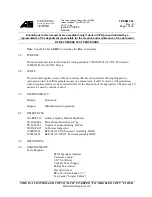
Operating instructions and documentation
4.65H/ 4.65 plus
- 32 -
9.2 Erecting and dowelling the lift
It is necessary to dowel the columns at 4 points and to safe the lift against slipping. Therefore a
concrete floor without reinforcement, thickness of 160 mm and quality C20/25 is needed. In case of
doubt perform a test drill and put a dowel in. Afterwards fasten the dowel with a specified torque. If
the necessary torque is too low or if there are cracks in the concrete floor, erect a foundation in
accordance with the sheet "foundation plan". Pay attention that the installation place is even to
guarantee a horizontal erection of the lift.
• Put runways on two erection trestles at installation place, pay attention to exact difference between
the runways (refer to data sheet).
• Position the crossbeams on the face of the runways, and put the plugs together.
• Mount the ropes (see picture 5).
• Position the columns at the ends of the crossbeams.
• Line up operating column (with bubble level) and drill holes for dowel-fixing through four bore-holes
of base plates. Clean bore-holes with pressure air. Put in the safety dowels with washers in borings.
• Take carrying ropes through columns to upper side and fix them in the head plate
• Check the position of the lift and the position of the operating columns again.
• Bore holes to fix the dowels through the borings of the base plates. Clean holes with
pressure air. Put in safety dowels with washers in borings.
The manufacturer demands LIEBIG safety dowels type B 15 (German dowel manufacturer) or equal
dowels of another manufacturer (with allowance) but observe their regulations! Before doweling
check concrete floor with quality C 20/25 concrete floor goes to the top edge of the floor. In this case
the dowels have to be chosen according to picture 6. If the ground is covered with floor tiles, the
dowels have to be chosen according to picture 7.
• Tighten the dowels a little.
• Connect power supply:
Pull the
electrical cable (5x 1,5 cable)
from the hydraulic-unit (under the rail) via the crossbeam and
through the energy chain to the top of the operating column.
Pull the
control line (7x1 cable)
(see pic. Connect the operating unit as well via crossbeam through
the energy chain to the top of the operating column and afterwards from the topside through the
cable channel to the key switch.
• Tighten the screws at the crossbeam.
• Fill in the hydraulic-oil, approx. 10 litre.
• Raise the lift a bit with the key switch and push the override switch at the side of the rail
simultaneously.
• Remove the erection trestles.
• Mount the safety ratchets in the column - if necessary lower the lift.
• Lower the lift in the ratchet (read chapter “lowering in the ratchet)
• Line up the columns with a help of a bubble level again.
• Tighten the dowels with the dynamometric key
Each dowel must be tightened with the demanded torque. Otherwise the normal function of the lift
can not be guaranteed. Observe the regulations of the other dowel-manufacturer.
• Mount the ramps and the loading ramp.
• Adjust the sliding guidance at the crossbeam (approx. 4-5 mm movement between the sliding
guidance and the column).
• Adjust regular height of the rails at all of the four columns by moving the nuts, which fix the carrying
ropes in the head plate. For demanded measuring accuracy of all important vehicle manufacturer it
is necessary to install the lift very exactly and to line it up. For this to the following points should be
paid attention.
Summary of Contents for 4.65H
Page 9: ...Operating instructions and documentation 4 65H 4 65 plus 9 2 5 Declaration of conformity ...
Page 11: ...Operating instructions and documentation 4 65H 4 65 plus 11 3 3 Datasheet ...
Page 12: ...Operating instructions and documentation 4 65H 4 65 plus 12 ...
Page 36: ...Operating instructions and documentation 4 65H 4 65 plus 36 9 7 Position of the columns ...














































